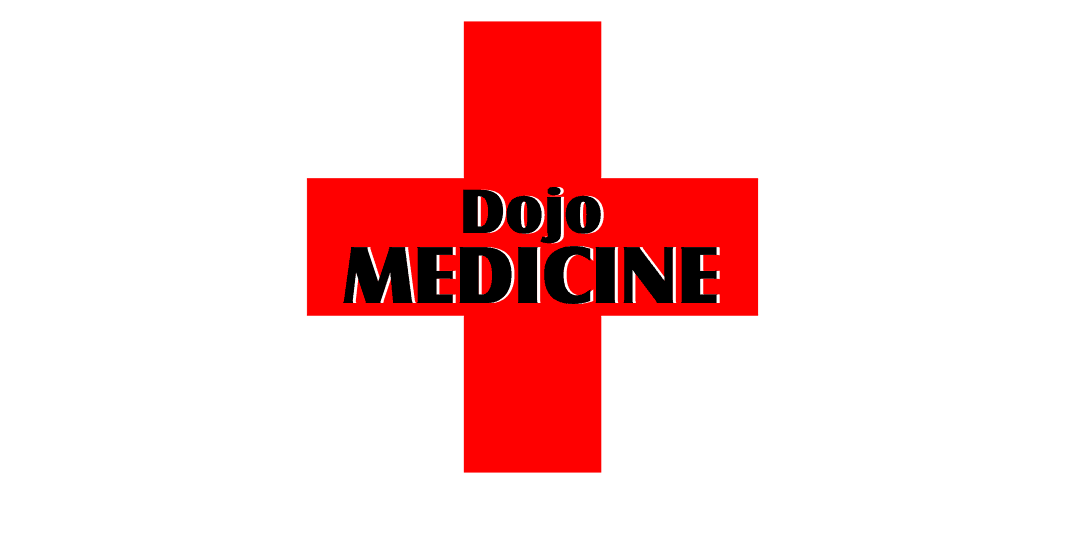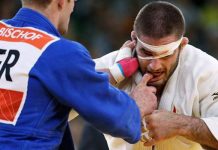Dan Harden’s Dojo Medicine: Management of Dojo Injuries
As martial arts instructors we will all face the occasional student training injury and we should be at least somewhat versed in the management of dojo injuries. The focus and intent of this article is not to make every Sensei out there a physician or EMT. My intent will be to focus in on a logical approach to dealing with dojo-related injuries and a methodology that can be easily adopted by instructors. It is the same methodology that has served me well as a Flight Surgeon and health care professional for more than 25 years. As we do this we will review some cases from the dojo experience and try to gather some teaching points from these real world occurrences. Useful dojo first aid can help mitigate an injury and reduce an emergency situation to a less urgent one that will literally help the student recover faster—and help to keep the dojo doors open!
As a practicing healthcare professional, I have certain biases to the approach, treatment, management, and response to an injured student that perhaps another instructor (with no medical background) may not consider. But therein lays a substantive reason for this article. As both a healthcare professional and an experienced martial arts instructor, I have significant experiences from both the treatment room and the dojo to draw upon. My further background in emergency medicine, military medicine and wilderness medicine will obviously render a perspective that many martial arts instructors may not normally be exposed to, and I hope this will provide a useful overview for dealing with Dojo training injuries.
Preparation and Prior Planning:
First off, as professional martial arts instructors and school owners, we should always take a lesson from the lawyers and use some form or version of a liability waiver that all of our student’s should be required to sign. An attorney would note that liability waivers are certainly not completely fail proof, but they do mitigate the liability risk we may incur in some ways. In the military, we follow safety regulations and risk mitigation principles. I like the rule of “P” which states that “Proper Prior Planning Prevents Poor Performance.”
Along with the liability waivers you can also ask students to voluntarily list any medications they take, provide a medical history, allergies, chronic illnesses, and to state their own level of perceived physical fitness. Take the time to explain to the student what they will be expected to do and allow them to ask questions regarding how rigorous your training programs are or how dangerous they might be. Certainly if you teach Iiado and occasionally use razor sharp blades in test cutting students should be aware of that type of exposure might put them at risk of serious bodily harm.
Medical surveys can be a bit of an issue, since the medical information contained needs to be secured and kept private between you and the student. However, when emergent problems occur, having that back ground information is very helpful and can in the long run save a life. You should also assure that you have good contact information numbers in case of an emergency so you can notify the family if there has been an injury during a training session. Risk mitigation and risk analysis experts generally agree that prompt contact notification and open communications are the best way to reduce possible legal problems down the road. Finally, it is also a good idea to have a file that is available to your instructors that include phone lists for local hospitals, strip maps to local hospitals and acute care centers, and the addresses and phone numbers for your emergency contact information. Now that we are done with the preparatory issues let us consider training.
Instructor Certification:
Our instructor program includes a requirement for all basic instructors to take a basic first aid class that we teach and to pass the American Red Cross Basic Cardiopulmonary Resuscitation (CPR) course as part of their instructor’s training. They are required to maintain that certification on an annual basis and demonstrate current certification. Additionally, we have a defibrillator on site and we have regular biannual use reviews provided by some of our local fire fighters who help to teach students about its use (we also have a battery check log and a function log that keeps this rather expensive piece of equipment in good working order). The reality of American fitness is that we are not very fit and we are in fact one of the most obese populations on the planet. Because of this issue our rates of heart disease are excessive. An instructor who spends the extra time and money on training his personnel may save a life because of his preparation. Certainly, it is a contingency that can be mitigated with a relatively minimal investment and a few hours of training.
Scenarios:
I like to start at the head and work my way down when it comes to injuries and take this as a common sense approach. The head is best protected by requiring headgear during training and sparring. Many ground artists develop very disfiguring cauliflower ear syndrome that can be prevented with proper wrestling equipment. Eye injuries and bloody noses can be prevented with appropriate required training gear. With that instructors should advise students on recommended personal protective equipment and have required minimum equipment sets listed. Also, loaner gear and dojo gear can also be available (keep it sanitized) for students who cannot initially afford the protective equipment.
Equipment:
Personal: Mouth piece, head gear, gloves, boots, groin cup, chest guard, shin and instep.
Dojo: Puzzle mat, floor mats, or crash pads as appropriate. (Cover or pad sharp edges and surfaces).
Regular maintenance on all equipment.
Scenarios:
Next let us take a look at the more common dojo injuries that you might want to think about preparing for and understand how to approach, assess, and deal with (note: I did not say treat). I’ve included four representative cases studies of injuries commonly encountered in the dojo to give you of sampling of what you can expect to encounter. Each of these scenarios actually occurred in my dojo over the course of twelve months. The intent of this article is not to give you a comprehensive overview of every type of injury that may occur in the course of an individual’s martial arts training, but to present an applicable and practical understanding of the varied categories of injuries I have witnessed over the forty plus years as a martial artist and an instructor and that you can expect to see.
The Approach to injuries and emergent situations:
Case Number One: (Bleeding)
You hear a scream from the other end of the Dojo and find that a kinder kicker student has been kicked in the nose while he was training. His nose is bleeding and the pulse of the dojo literally gets a shot of adrenaline. Family, fellow students and prospective customers are witnessing this story unfold in front of them. What should be your first step? In medicine we tell practitioners to “take their own pulse first”. Stay calm because quite literally all eyes are going to be on you to assess how you handle the situation. Remember the Karate Kid movie? In the general public there is a perception that martial art instructors understand something about first aid and medicine. Here is a step-by-step approach that works. It may not stop the crying but if handled in a professional manner the confidence your students have in you could increase greatly.
Scene Assessment:
Look at the scene and determine what the mechanism of injury was, how severe the injury could be, and how can it be mitigated it in the future? Most importantly how do you approach it now in order to prevent further injury and re-establish order and confidence in the teaching and training methods of the dojo?
The Initial Survey: First responders (i.e., Emergency Medical Technicians and Paramedics) use an approach known as the “primary survey” for assessing injuries. The primary survey assesses the airway, breathing, circulation, disability, exposure, and follow up requirements of any victim of an accident or injury. This is commonly called the “A, B, C, D, E, and F approach” to emergent care. We can easily apply these rules to the dojo. In our example of the child with the bloody nose let’s look at how we would apply this approach: Airway: There’s lots of loud crying and tearful sobbing going on so the airway is certainly clear. Breathing: Well, you have to be breathing to scream that loudly. Circulation: his nose is bleeding openly so it’s clear that he is maintaining active circulation. Disability: he is holding his nose walking around in circles and telling you it hurts so it’s clear that his injury has not completely disabled his ability to move around or comprehend what has happened. Exposure: yours and his, you can visualize his face and bleeding nose, so the exposure of the injury is clearly evident. You may want to consider having rubber gloves at the dojo to reduce your exposure? At this point, you should note that you have largely completed the entire primary assessment and have not even taken the first step towards him—but it is already rather clear that he will probably be fine. Now the real issue comes into play: what do you do for this student (your follow-up)? That answer varies based on your back ground.
I will give you my approach to this scenario.
First Aid for this bleeding nose: Stay calm and “take your own pulse first”. Run through the A-B-C-D-E-F approach in your head. Talk to the student and take charge and ownership of the situation. By that, I mean move aside all of the on lookers give the child room to calm down and help relax the situation. Since he wasn’t knocked out and his level of consciousness is good, the likelihood of any cervical (neck) injury is likely low—but never ignore the fact that this was a small child and he was hit by a bigger student. So, we have the student sit down and we comfort the student. The next step is direct pressure by pinching the nostrils together. Have them (or a parent) do this for a “full ten minutes”. Honestly, most patients never do this, as they will let go to blot the nose after a minute or two, and it allows the bleeding process to start all over again. The only way to effectively control bleeding is direct pressure, so try to effectively “enforce” that control for a full ten minutes to achieve maximum effectiveness. An ice pack on the neck is helpful as a comfort measure because it helps to cool the body’s core temperature (which will be likely elevated as a result of the injury due to emotion and fear) and it will certainly make the student feel better. Once the bleeding is controlled the student should be advised to seek care with his primary care provider to ensure there isn’t a more severe underlying injury such as a broken nose or other issue in this case. Under no circumstances should the student be allowed to rejoin the class. As a safe rule of thumb, once blood is drawn on the dojo mat, the training session is over for the day for the injured student. Even the toughest young martial artist needs time to heal once injured. This measure will ensure that an atmosphere of “safety first” dominates your dojo, increasing confidence in you by students and their families alike.
Conclusion: (“Pearls”)
1. Check your own pulse first! Stay calm and stay in charge.
2. Keep the “A-B-C-D-E-F” of the primary assessment process in mind.
3. Hold direct pressure on bleeding and keep it constant for at least ten minutes.
4. Have ice packs in the refrigerator and have access to bulky clean gauze and gloves.
5. Do your homework and know the history of your clients. In this scenario if they were older and on aspirin then the bleeding could have been brisk and more difficult to control.
6. “When in doubt, ship them out!” In other words, if you are concerned with your own ability to control the situation, don’t hesitate to call 9-11 to get them professional medical assistance.
Case Number Two: (Sprains and Strains)
A female student is throwing a roundhouse kick and her foot sticks on the rubberized mat surface. You hear an audible “pop” and she immediately limps off the mat and sits down. This is a tough girl and a local college student who has trained with you for years so you know that this is not the norm for her. She doesn’t normally cry “wolf” or complain over minor injuries so it’s clear that something is amiss here.
So let’s change gears and this time look at the approach to musculoskeletal injuries.
Scene Assessment:
Look at the mat surface and check to see if there was something that physically caused this to occur. Is the tape at the seam loose or did her foot get stuck in the fold of a folding mat system. These sorts of assessment can help to mitigate and reduce any future occurrences. In this story the mat surface was completely level and she simple twisted her ankle.
Initial Survey:
As with all injuries or accidents in the dojo, run through the A-B-C-D-E-F in your head as you make your assessment (it helps to make this a routine). If the student walked or limped to the bench and was able to weight bear after the event the likelihood of a fracture can be reduced but never eliminated unless you have an x-ray machine in your dojo. In musculoskeletal injuries, we tend to focus more on the “D-E-F” portion of our approach. If they have trouble walking or if they cannot walk and there is an obvious deformity then the decision is immediate and obvious. They go to straight to the Emergency Room (ER)—and if it’s that obvious, it’s better that they be taken to the ER by ambulance versus risking a worsening of the injury by relying on non-professionals to deliver them to competent medical care. If you have some training in basic first aid and fracture management and are comfortable splinting the limb, then you should consider doing so. Splinting helps to reduce the movement of the injured limb and can protect it from displacing if there truly is a fracture. If you don’t know what you are doing and haven’t had any training, then leave it alone. Trying to splint a fracture correctly usually means restoring anatomic alignment of the bones which can hurt—oftentimes severely—and worsen the injury if not done correctly. Splinting also requires that you know how to check for a pulse rate distal (farther) away from the sight of injury to ensure that adequate blood flow is being maintained. An incorrect splinting can have the affect of a tourniquet causing the blood flow in the limb to be severely reduced or in the worst case completely restricted. This can lead to a very dangerous medical emergency which could result in the loss of that limb.
The standard fall back that every instructor should at least understand is the “RICE” acronym, which stands for Rest, Ice, Compression, and Elevation. This type of minimal treatment will help to reduce pain and swelling, and will in some cases reduce down time for the injured student. For rest (R) I usually advise two weeks and play it by ear, based on how well the student is doing. Ice (I) can be used in the first stages of an injury and can actually increase blood flow and removal of damaged cells while reducing swelling. For compression (C) I prefer using an ace wrap. You should have several of these at your dojo, ranging in size to accommodate the area/type of injury (e.g., small wraps for ankle or wrist injuries and larger ones for shoulder and thigh injuries). The very largest ace wraps available for sale at your local pharmacist’s shop can be used to hold the ice packs over the site of the injury and also to compress and reduce the swelling at the site. Finally, elevation (E) is used as a very effective means for reducing swelling and even pain. The rule of thumb in elevation is that it is always best to elevate the injury above the level of the heart to help reduce blood flow to the injured area.
Conclusion: (Pearls)
Check your own pulse first! Stay calm and stay in charge.
If they are weight bearing it can be a sign of reduced risk for certain types of fractures (knee injuries). In other words if they are walking on it then it is likely to have a better outcome.
Splint only if you know what you are doing! Improperly placed splints can have a tourniquet effect and cause more harm. It requires you understand how to restore anatomic alignment and check for distal circulation beyond the injury site.
Observe the “RICE” protocol with all musculoskeletal injuries—rest, ice, compression and elevation.
Keep Ice Packs in the dojo refrigerator and maintain various sized ace wraps to use when these injuries occur.
Case Number Three: (Cardiovascular and Heat Injuries)
In today’s dojo, students range the spectrum from the very young to our more senior population. I always find it particularly satisfying when I go to Aikido Seminars and note the number of much older practitioners I see on the mat and still being physically active! Certainly, that is the trend with many other martial arts as well. This story is about one of my more senior tae kwon do students. I noted that on a particularly challenging tae kwon do session he looked a little pale and was not his on par with his usual all out approach to training. The student had been a boxer and weight lifter so he always trained hard. He had filled out the waivers and I was familiar with his back ground but he had omitted the voluntary information regarding any medical history.
Scene Assessment:
A fifty something year old karate student starts looking pale and is sweating profusely. When you talk to him he seems to be acting a little differently and you start to question him to see if he is all right. In this case the “C-D” (i.e., circulation and disability) should be the focus of your approach to taking care of this martial artist. He is not as sharp in his answers as he normally is, and you find out that he is taking medication to control his elevated blood pressure. With that your suspicion escalates and in this case we immediately advised that he should be seen in the ER. Certain things enter into your mind on this and number one must be cardiac issues. He had no shortness of breath and he denied any chest pain but still he should be evaluated. The other possible source is dehydration and heat injury, which in this case is exactly what it turned out to be. Certain medications will reduce a student’s physiologic ability to get rid of heat load. Instructors need to be aware of their environment. Our air conditioning was out and that increased the risk for this injury. I know the traditionalists are smiling and I appreciate their points because I never had an air-conditioned dojo when I came up through the ranks but I started training when I was nine and not in my mid fifties. Conditioning must be a consideration and this student is classic for exertion heat injury but the blood pressure medication and the other risks escalated his risk.
Initial Survey:
If you have a more senior student complaining of shortness of breath, dizziness, chest pain or has a dusky appearance then cardiac problems really ought to be considered. Circulation and disability always need rapid assessment since stroke or sudden cardiac death could be in question. If there is any question in your mind that there is a circulatory or cardiac issue going on than a call to 9-11 to transport the student to the nearest ER is immediately in order. If you think that getting them into a personally operated vehicle and transporting them to medical care will help accelerate their access to an emergency room then this is where the strip maps and contact numbers really help speed up the process. Additionally, based on your experience level, you may consider purchasing a defibrillator—but if you have the equipment make sure you know how to use it.
This scenario reinforces my point about learning how to perform cardiopulmonary resuscitation (CPR) and defibrillation as well as making sure to rehearse these types of scenarios with your staff and maintain your active certifications. In this case the student had symptoms of dehydration that can mimic cardiac issues, particularly in the presence of certain types of blood pressure medications. Heat stress is rather straight forward and can be treated with rest, fans, and fluids. We keep a plant mist sprayer in our dojo. They are wonderful and can be sprayed on the student’s skin to restore the evaporative cooling effect. If it is more severe certainly ice packs can be used over major arterial areas (e.g., the neck, groin and thighs) to help facilitate cooling. However, be cautious with ice packs because it can trigger shivering which in the long run will produce more heat load and worsen their status. Fluid replacement is essential and the sport drinks when diluted by about fifty percent with plain water are ideal for rapid fluid replacement requirements.
Conclusion: (Pearls)
Check your own pulse first! Stay calm and stay in charge.
If you suspect a circulatory or cardiac issue (stroke or heart attack) get them to the nearest emergency room as soon as possible. My take home is, “When in doubt, ship them out!”
Heat Stress and Dehydration can be addressed with fluid replacement, cessation of the activity and if they are truly stressed mist sprays and diluted electrolyte drinks can help a lot. If the students become nauseated and are vomiting then they to need to go to the emergency room. When students vomit they loss large amounts of gastric salts that are difficult to replace without an intravenous (IV) infusion. If there is no vomiting then use the gut. On average we can absorb about 1.5 liters of fluid through our gut in an hour. Olympic marathoners in documented studies can loss up to 3 liters of fluid via sweating in an hour, so as you can see dehydration can occur in a fairly short time with severe exertion.
Risk Mitigation Strategies: Functional air conditioning, mist sprayers, Gatorade/Power aid supplies in the dojo refrigerator, rest cycles and routine water breaks if training sessions are longer than thirty minutes.
Summary:
Obviously, I cannot review every scenario you may encounter as a martial arts instructor. The material presented here is meant as discussion only and not meant to replace common sense and your personal judgment. Hopefully, this brief set of examples will stimulate some thought on the subject and begin the process. There are a host of things to consider in order to be prepared for an emergency. I personally think the most important preparation is to learn to slow down when an injury occurs, take a breath check and “control your own pulse first” in assessing a dojo injury or emergency.







